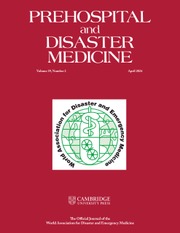No CrossRef data available.
Article contents
Feasibility and Effectiveness Assessment of the New Triage System Adopted by the Disaster Medicine Service of Regione Piemonte: Results of a Controlled Randomized Study
Published online by Cambridge University Press: 13 July 2023
Abstract
Validation of the new MCI Triage protocol of Regione Piemonte by comparing it with the already published and internationally used START/Jump START protocol. Compare its accuracy, execution time, over and under triage indices and the influence of any rescuer characteristics in reference to adult and pediatric victims when in use in a simulated multi-casualties event setting.
We conducted a randomized controlled experimental study in a simulation setting. A group of 35 people involved in an incident (volunteer participants) was assessed by a population of trained and untrained healthcare professionals (nursing students and nurses). The participants were randomly divided into two homogenous groups to which the two protocols were explained separately and carried out the simulation in single-blind. Evaluation data were collected and statistically processed. The resulting items were used to compare the accuracy, over- and under-triage rates and any items related to rescuer characteristics for each triage system.
74 subjects were included in the study. Of these, 56.7% were healthcare professionals in training and 43.4% were trained nurses. Compared to standard criterion definitions, the MCI triage protocol showed a higher accuracy rate than START (88.4% vs 80.4%, p<0.01). MCI triage had a significant lower rate of underestimation compared to START (8.9 vs 13.6%, p< 0.01) as well as overestimation (3.2% vs. 6.8%, p< 0.01). Time is only correlated with the performance of MCI triage, influencing its accuracy. There were no significant differences in the accuracy of diagnosis in pediatric patients.
We found that MCI method triaged adult patients more often correctly than START method. Underestimation and overestimation were lower than in the control method, although there tended to be a significant overestimation of white codes which were not present in the START system. In the assessment of pediatric patients, the protocols are equivalent.
- Type
- Lightning and Oral Presentations
- Information
- Prehospital and Disaster Medicine , Volume 38 , Supplement S1: 22nd Congress on Disaster and Emergency Medicine , May 2023 , pp. s29
- Copyright
- © The Author(s), 2023. Published by Cambridge University Press on behalf of World Association for Disaster and Emergency Medicine





